How best to organize garage heating: a comparative review of the best methods
The garage is a multi-purpose room. This is where a car or motorcycle is stored.Here, as a rule, there is a cellar with preparations for the winter, as well as an impromptu repair workshop.
It is not surprising that with the onset of frost, the imprudent owner of this building has problems. Therefore, heating a garage is a task that is best solved in advance.
In this article we will analyze in detail the main methods of heating a garage and materials for wall insulation. We also provide useful recommendations on observing safety measures when using individual heating.
The content of the article:
Why do you need a warm garage?
We live in a huge country with a rather harsh climate over most of its territory. For this reason, the garage remains a reliable refuge for the family vehicle not all year round, but only from October to April.
And this circumstance does not depend on the material from which the structure is constructed. Structures made of brick, concrete and cinder block freeze equally during real cold weather.
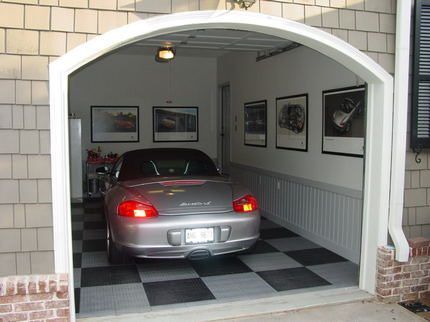
The microclimate that forms indoors during frosts can cause serious damage not only to the car, but also to the building itself. Cold temperatures promote the formation of condensation on the metal surface. This is what causes corrosion of the car body, garage doors and other structures susceptible to rusting.
In addition, in cold weather the car may not start. Not to mention the potatoes in the basement, which may freeze. And it’s impossible to work in such a dank room without fear of catching a cold.
Basic methods of insulation
Naturally, on the eve of cold weather, there is a desire to insulate the building in all possible ways. The sooner this desire appears, the better.
In addition to the heating scheme and option, it is advisable to think in advance and provide for ways to reduce heat loss, which include:
- Polystyrene foam (expanded polystyrene). This material is excellent for gate panels. If you compare it with such fibrous insulation materials as mineral wool, glass wool and slabs created on their basis, then polystyrene foam will cost you less. In addition, it is more durable and does not absorb moisture. Don’t forget about the anti-corrosion protection of the gate metal.
- Glass wool (mineral wool) slabs. This material, along with foam plastic, is used for internal cladding of walls and roofs. The boards are glued to the surface using special freshly prepared adhesives. The slabs themselves are protected from mechanical damage and moisture by plaster, which is reinforced with fiberglass mesh to increase its strength.
- Siding. Or other cladding systems fully prepared for installation. All this finishing serves to externally protect the building from frost.If the garage is a separate building as part of the estate, then it can be faced with decorative bricks.
- Thick curtain. Metal garage doors are poor protection against frost. A curtain that does not allow flows of cold air to pass through can be constructed using a suitable-sized piece of dense polyethylene 0.8 mm thick or tarpaulin. This design is attached in the same way as a regular curtain.
It would be better if a kind of curtain could be pulled apart when the car leaves or enters.
The garage roof is insulated both inside and outside. As additional protection for the gate, foam boards attached to the gates can be covered with plywood or clapboard. Additional ventilation is installed as mandatory insulation measures. It will help remove not only exhaust gases from the room, but also excess moisture.
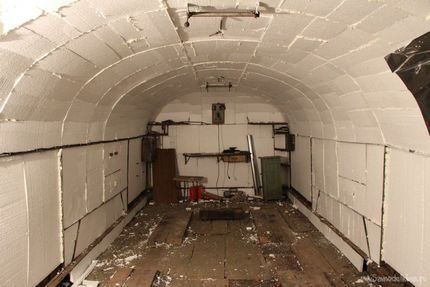
Materials suitable for insulating a garage are also used as insulation for walls, floors and ceilings of a residential building. And the technology for their installation will be similar. In this regard, we recommend that you familiarize yourself with the insulation instructions and detailed tips on choosing the right material:
- Insulating the ceiling in a house with a cold roof: types of effective insulation + installation instructions
- Types of insulation for the walls of a house from the inside: materials for insulation and their characteristics
- Floor insulation using joists: materials for thermal insulation + insulation schemes
Heating type suitable for garage
Having taken all the necessary measures to prevent heat loss from the room, we can think about organizing its heating.If the building is not insulated enough, then we will heat the street, but the effect we need will not be achieved. Of course, we don’t need the same warmth as in an apartment, but a temperature of +5 °C is our goal.
Next, we will consider the most suitable heating systems that can be used in a garage. And let’s look at their main advantages.
Water heating system
Using water heating system The coolant is water. It circulates in a closed circuit, which includes a boiler, pump, pipes and heating radiators.
In a simplified way, the heating process looks like this: heat is generated using a boiler, water is heated, and then, with the help of a pump, it moves through pipes to heating radiators. Here the water gives off the received heat, warming up the room, after which it returns to the boiler again, closing the circle of its circulation.
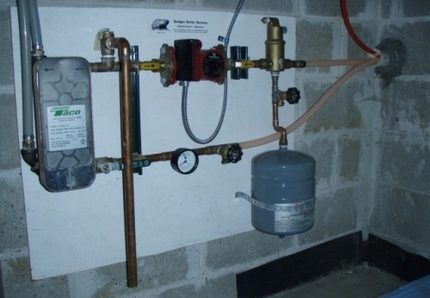
The advantages of water heating for a garage are:
- Long service life. Indeed, if the system is installed in compliance with all the rules, and it is operated carefully, it can serve properly for a very long time.
- Maintainability. Each element included in the circuit, if it suddenly fails, can be dismantled and replaced.
- Safety. Water heating is highly safe and environmentally friendly.
As we can see, the advantages of this method are significant, but water heating in garages is used very rarely. Most often this happens if the garage is part of a single heating system with a residential cottage.Such heating is also used in garage cooperatives if the heated objects include several permanent buildings united into a single network.
When the garage is located far from centralized heating, the costs of equipment and insulation of the heating system make it unprofitable. In addition, the water in the system will have to be replaced with antifreeze.
The greatest effect from the use of water garage heating can be achieved in buildings made of brick or solid concrete blocks. This type of heating is not used in structures made from metal profiles or other lightweight materials.
Air heating system
Various devices are used for air heating: heat guns, curtains and special fans that force heated air into the room.
The operating principle of all of these devices is the same: the air is heated by a heater built into the device and distributed by a fan, which is also located inside the product.
Application air heating for the garage will allow you to quickly heat rooms of different sizes. If you direct the air flow towards the car, you can quickly remove all the moisture even underneath it. Some of the air devices consume electricity when connected to a regular household network. Others use other types of fuel to heat the air.
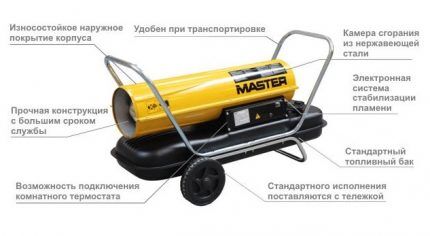
An example of an air heating device is the same heat gun. It must be turned on when visiting the garage. It warms up the room in a matter of minutes. The durable casing of this device contains a powerful fan, with the help of which the heat from the heating element is distributed throughout the room. But it should be borne in mind that in the absence of the owner, the garage will freeze.
The advantages of air heating are:
- The room can be heated very quickly.
- The room temperature will be maintained at the desired level.
- Air heating devices are easy to use.
Significant disadvantages include the fact that the air flows created can raise dust in the room. In this case, regular cleaning cannot be avoided. In addition, we have already considered the disadvantages of devices powered by electricity.
Best Garage Heating Options
A garage space can be heated in several ways. Each of them has its own advantages and disadvantages. We will try to provide you with all the necessary information about each of the popular garage heating methods so that you can choose the one that is right for you.
Option #1 - heating using gas
Gas itself is a relatively cheap fuel. Therefore, it is also used to create a garage heating system. But to create a heating system using this fuel, financial investments will be needed.
The most money will be required to purchase all the equipment necessary for installing the heating system, as well as to pay for the services of specialists who will perform this installation.
The cheapest option for gas heating in a garage is assemble a gas cannon with your own hands.
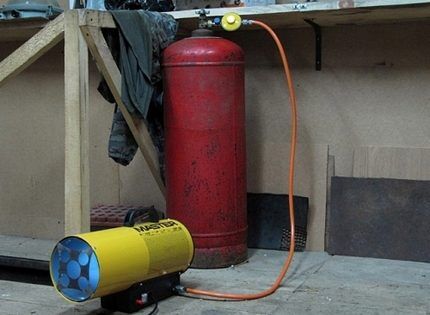
Difficulties may arise at the stage of obtaining permission for gas heating from services that are authorized to issue these documents. Without permission, installation, commissioning and the very use of gas equipment is not only illegal, but also dangerous. After all, gas is one of the explosive materials.
So, the advantages of heating a garage with gas include:
- affordability of fuel;
- high system efficiency.
With such heat transfer, the economic efficiency of this system is obvious.
Let us also remind you about the disadvantages:
- Potential danger of this type of fuel. Let us remind you once again about the explosiveness of gas.
- Significant costs associated with equipment installation.
Such a heating system becomes profitable only if the source of gas is a centralized gas pipeline into which it is allowed to make a connection. If you have to bother with regularly refilling empty cylinders, then all the advantages of using gas will simply fade.
Option #2 - using electricity for heating
Modern electrical appliances can also be used as a heat source. Moreover, the range of such heaters offered by the market has expanded significantly in recent years. You can find everything from cheap fan heaters and ending with solid convectors and infrared models.
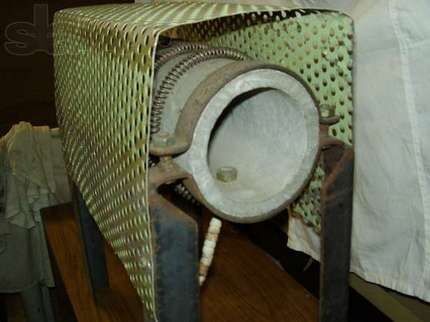
However, electricity has previously been used by garage owners to heat rooms. Most often, a device for this purpose was constructed in a makeshift manner: a nichrome spiral was wound onto an asbestos-cement pipe. This is how the “goat” turned out. This is a fairly powerful heater, consuming up to 10 kW per hour of operation.
In order to avoid unnecessary expenses, it is necessary to carefully calculate exactly what power the device should have in order to fully heat the room, but not to overdo it. Excessive heat negatively affects the paintwork of your “iron horse”.
This is precisely the danger that can await those who install an infrared heater not above the entrance, where it belongs, but close to the car. In general, the operating principle of this device is precisely that infrared radiation emitted by an element made of quartz glass or glass ceramics heats the surrounding objects, which already warms the air in the room.
Therefore, an infrared heater is placed above the entrance to the garage, on the ceiling. From there it successfully heats the floor. Please note that this appliance should not be left switched on unattended. Its heating can reach significant temperatures.
The advantages of this method are:
- A wide range of electric heaters from which you can choose the one that will ideally match the parameters of your structure.
- There are no difficulties in the process of bringing the heater into working condition.
- Operating such a device is as easy as shelling pears.
However, heating a garage with electricity also has a significant drawback: it requires electricity. If there is no electricity in the garage at all or it may be turned off unexpectedly, then the heating simply will not work. And, yes, the price of this type of fuel is rising every year.
Option #3 - use oil waste
There are stoves that use waste oil to operate. They are not often used to heat a garage, but since this method also exists, consider it.
The great advantage of this method is that working furnace You can do it yourself to heat your garage. This work requires certain skills, but the design of the stove is not too difficult for a home craftsman. For its operation, waste material is required - waste material, which can be obtained at the nearest service station. So there should be no problems with fuel.
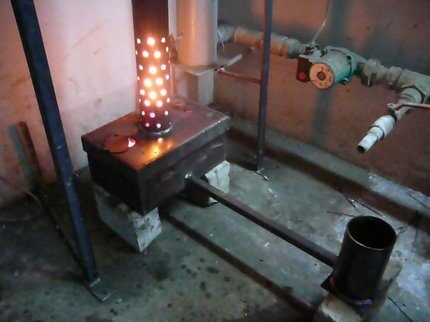
The process of igniting the furnace during mining is quite simple. A little paper is placed inside the device, after which one liter of used oil should be poured into it. The paper is set on fire. It only takes a few minutes for the oil to boil, then the oil vapor will ignite. You need to add 5 liters of waste. This is done during the combustion process. You can use any fuel based on oil.
This method has enough advantages:
- Free waste is used as fuel and is intended for disposal.
- The ambient temperature does not affect the quality of the furnace.
- The design of the furnace is considered fireproof, since waste vapors burn without forming an open flame.
But within the advantage lies the disadvantage of this system: to store fuel in the garage, you need to find a separate place, which should be equipped in compliance with all fire safety measures.
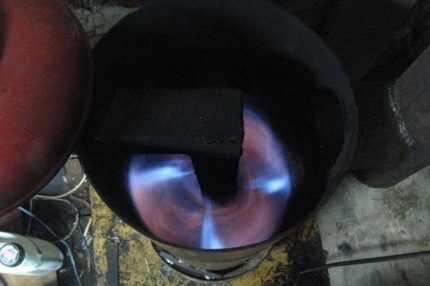
In addition, the operation of the furnace during mining requires the presence of a special chimney, the length of which should not be less than 4 meters. There cannot be horizontal sections in the channel of this chimney. It will have to be cleaned at least once a week, so it is better to provide a removable structure in advance.
Option #4 - solid fuel heating
Solid fuel heating has never taken a leading position in the list of heating systems used in garages. Everything changed with the advent of new boilers capable of providing long-term combustion. Now this method deserves your attention. Especially when you consider the fact that some types of boilers can be made independently, and such a unit will cost very little.
Among industrial production models, it has proven itself well pyrolysis boiler. It is capable of maintaining the optimal room temperature for 6-12 hours. Pyrolysis is a process occurring in a boiler, which consists of burning solid fuel separately from the substances released during combustion. This feature allows you to maintain a constant temperature in the room.
For the operation of a pyrolysis boiler, forced draft is required. As a rule, this problem is solved with the help of a fan. The pyrolysis boiler must be cleaned periodically.
There is also a pellet boiler, which uses solid fuel in the form of granules compressed from sawdust and shavings - pellets. Pellet feeding into the firebox is carried out automatically using a hopper or screw container. If you don’t forget about ventilation, the boiler will work properly, heating up the more the more pellets are poured into it.

Advantages of solid fuel heating:
- This heating system can also be used where there is no electricity.
- You can build a simple boiler with your own hands.
But we should not forget that during operation the solid fuel heating system is potentially fire hazardous.If you use it in a garage, then explosive and flammable substances cannot be stored in the same room as the boiler. Is it dangerous.
In addition, the garage should be equipped with a good hood, capable of removing combustion products. The air duct will need regular cleaning, and the boiler will need to be monitored.
General rules for safe garage heating
We don’t know which of the proposed systems you will choose, but we know for sure that, regardless of the heating method, you should follow the safety rules, which we want to tell you about:
- Consider a garage heating system not when cold weather is approaching, but during the construction stage of this room. This will greatly facilitate the implementation of many ideas.
- Operation of potbelly stoves is impossible if there is no high-quality supply ventilation.
- Gas heating is incompatible with the presence in the same room of explosive and volatile substances, as well as agents that can cause metal corrosion.
- The power of the devices installed in the building should not exceed the power of your network. Even if you think that this excess is insignificant.
- Electric heating involves installing a circuit breaker that will de-energize electrical appliances in the event of an overload in the network.
- If an extension cord is used to connect the device to an outlet, its length should not be more than 6 meters with a cross-section of 2-3.5 mm2.
- Items should not be placed on heating appliances to dry.
- Gas cylinders can only be stored in rooms that are above ground level. That is, they cannot be used in a garage with a basement.
- If gas leaks, it accumulates in the lower room.To get a full-fledged explosion in this situation, not only a match is enough, but also a simple spark that can jump when the light is turned on. If you are using a gas garage heating circuit, take a sniff before you flip the switch.
- All electrical appliances should be turned off at night. If they are needed specifically at night, they will have to be monitored.
- The normal microclimate of the garage is ensured by ventilation and high-quality thermal insulation.
You should also remember that heating equipment requires preventive inspections, which should be carried out regularly.
None of the above rules are impossible to implement. And all of them together ensure your safety.
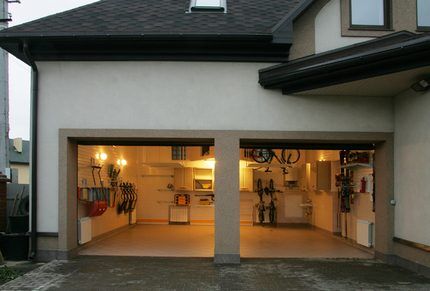
Conclusions and useful video on the topic
This video clip presents in detail the process of making a stove that runs on solid fuel (wood) for heating a summer house, garage or other buildings. The main part of this stove is a pipe with a diameter of 330 mm and a length of 500 mm.
With a full load of firewood and burning in smoldering mode, the generated heat is enough for 4-6 hours when heating a room of 15 m in winter2.
The second video is devoted to the arrangement and insulation of a garage in which infrared heaters are installed. It is valuable because it demonstrates some ways to insulate a garage, which will allow you not to waste the resulting heat.
We have presented to you the most popular ways to organize heating in a garage.Perhaps a fast heat gun will appeal to you, or perhaps an economical wood stove will catch your eye. If the garage is directly adjacent to the house, the choice is obvious: you need to include this room in the common water heating circuit with the house.
In any case, the choice is yours. For this purpose, we tried to collect arguments for and against for you.
Are you choosing the best heating option for your garage and want to ask a number of questions that we did not cover in this material? Or want to share your own experience of efficient heating with other users? Leave your comments, share photos and useful tips with other users.




Our garage also serves as our cellar at the same time. We store not only canned food in it, but also vegetables, and for this the temperature must be cold. Therefore, we do not need centralized heating, but only insulating the walls from the inside using polystyrene foam is suitable. And if you need to work in the garage, then the heater turns on for the entire time people are in it. For so many years of using the garage, nothing happened to the car. And the foam holds the temperature well.
I heat my garage with a regular wood stove. If I come across coal, I use it too. I used to have a homemade goat-type electric heater, but at one time the electricity was cut off at the garage cooperative, so I gave it to a friend. Then the electricity was returned, but they didn’t bother making a new goat. The only insulation is the foam plastic covering of the gates and the curtain curtain in front of them. Periodically in the winter I go and heat the garage.